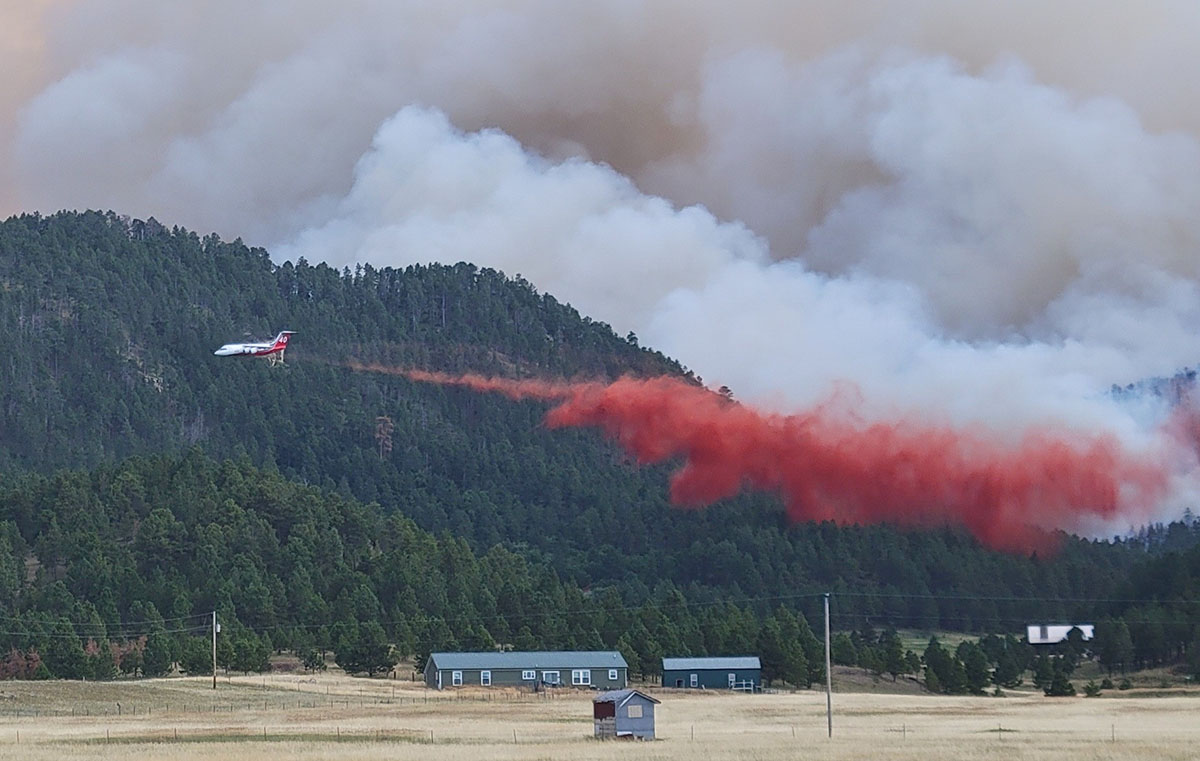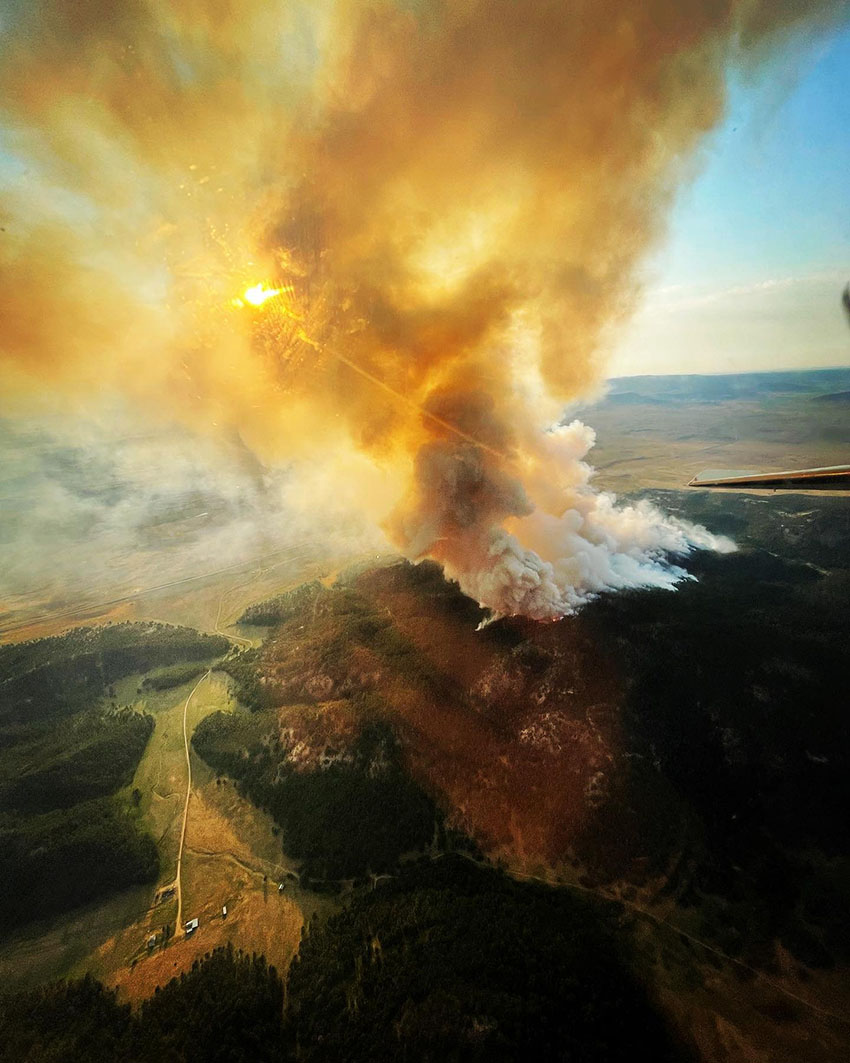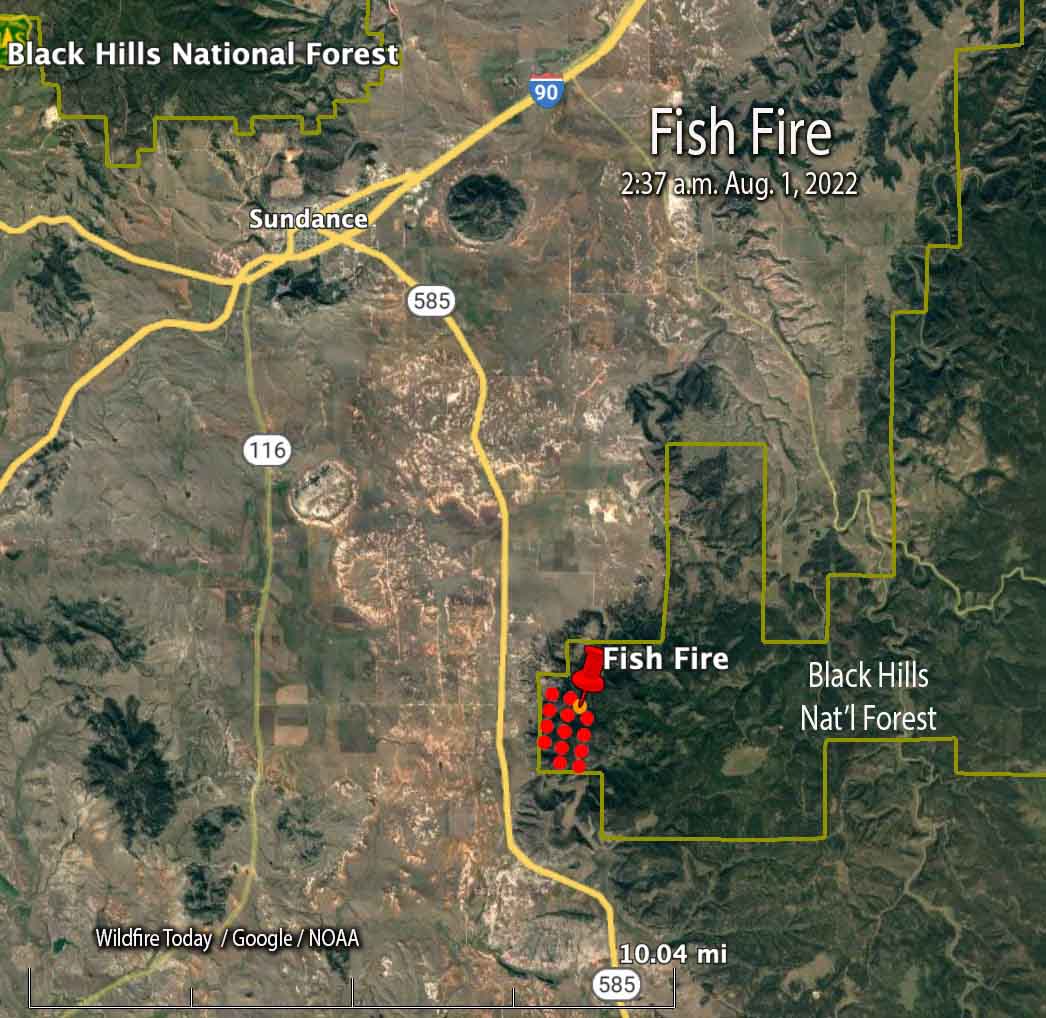Updated 8:46 p.m. MDT August 1, 2022

Fish Fire
The Fish Fire eight miles south-southeast of Sundance, Wyoming spread to the east Monday threatening the Canyon Springs subdivision. Crews are working in the area to provide protection to the structures. Monday afternoon it had burned about 750 acres.
To see all of the articles on Wildfire Today about the Fish Fire, including the most current, click HERE.
Residences from Canyon Springs Road to the south end of the fire and east of Wyoming Highway 585 are still under evacuation.
The fire started on private land and was human-caused.
A Wyoming Type 3 incident management team is expected to arrive and in-brief Monday at 6 p.m.
The smoke from the fire is blowing east into South Dakota toward Lead and Rapid City .
It is a fairly big air show for that part of the country. We checked a flight tracking app late in the afternoon Monday and spotted four large air tankers at the fire or at the Rapid City Tanker Base 63 miles to the southeast — two BAe-146s and two RJ85s. Tanker 168, an RJ85, flew up from Abilene, dropped, and headed to Rapid City. There are also two Type 1 helicopters and a Type 3 helicopter assisting firefighters.
The state of Colorado’s PC12 multi-mission aircraft is also on scene for mapping and intelligence support. It found that at noon the fire had burned 527 acres.
Monday afternoon the Four Corners weather station south of the fire recorded 88 degrees, 13 percent relative humidity, and 10 to 20 mph winds gusting out of the west and northwest up to 32 mph. The forecast for the fire on Tuesday predicts 87 degrees, 21 percent RH, and 10 to 15 mph south winds shifting to the west in the afternoon gusting up to 20 mph.
Carter Canyon Fire
The Carter Canyon Fire seven miles southwest of Scotts Bluff, Nebraska has grown to 15,592 acres. The blaze destroyed three homes and damaged several more in the Carter Canyon community that was evacuated Sunday.
The temperature at the fire reached 102 degrees Monday with 16 percent RH and winds gusting at 10 to 15 mph. The National Weather Service forecasts temperatures around or in excess of 100 degrees over the next six days.
Large air tankers have also been assisting firefighters on the Carter Canyon Fire.
Updated at 9:54 a.m. MDT August 1, 2022

The map below shows heat detected by a satellite as it passed over the Fish Fire at 2:37 a.m. Monday.

We will update this article as more information becomes available.
10:20 p.m. MDT July 31, 2022

The Fish Fire 8 miles south-southeast of Sundance, Wyoming is prompting evacuations south of the city. Evacuation orders are in effect from south of Canyon Springs Road to the south end of the fire, and east of Wyoming Highway 585.
Since it was reported at about 11:30 Sunday morning it burned approximately 500 acres on the Black Hills National Forest by 7 p.m., according to fire officials. Air tankers and at least one Type 1 helicopter are assisting firefighters.
A Wyoming Type 3 incident management team is expected to arrive on Monday.

Another fire in the Northern Great Plains has been burning since 6:30 p.m. on July 30 seven miles southwest of Scotts Bluff, Nebraska. The Carter Canyon Fire has grown to approximately 13,000 acres, with part of it being within the Cedar Canyon Wildlife Management Area south of Carter Canyon.
Single engine air tankers as well as large air tankers have been working on these fires, flying out of Rapid City and Rocky Mountain Metropolitan Airport (Jeffco) near Denver. An air attack aircraft flew over from Cody, Wyoming to assist with the Fish Fire on Sunday.


Sounds like everyone knows this and that and requests certain equipment that’s useless. If Noone has ever fought a wildland or mountain fires are just putting their two cents worth in.
We need to knock these fires out as quickly as we can. Others will pop up. Resources will be getting thin.
and of course the arm chair ICs are demanding things. why don’t you sit down and chill out, these boys are damn good at what they do and that country isn’t the worst to fight fire in. evidently with your “type 1” background you would know that.
I’m with you Old Guy. Why mess around. Get it out
OK, Jimmy, let’s see how that turns out. Mine was not “a panic button” given my Type I background.
I hope you’re right.
This time of year is not for “those less experienced but mean well.”
I’ll tell ya what, Old Guy. Some of the best efforted and most efficient firefighting I’ve ever done was on a T3 incident. It was done with a rudimentary map taped to a tree, a pallet of MRE’, Cubees, Batts, TP and saw mix and a bunch of pipe hitters.
We hammered fires and actually put them out direct! Type 1 teams always f*^% around with superfluous garbage and are WAY WAY too top heavy and inefficient. They’re actually terrible and hardly a “team”. They always whine about Shots trying to get loops of chain but pay some structure dude portal to portal to make maps and sport eat whole wedding cakes all day.
Nope, I won’t even take an assignment on a T1 fire anymore since they’re all hat and no cattle.
Heck of a good comment! It didn’t use to be that way, but anymore it seems like 2-3 days to take the fire, indirect everywhere, and motels for everyone is the new standard. And waste mud dropping in areas with no boots on the ground, or so far away from the fire edge that it dries out and loses a huge percentage of effectiveness.
Wildland firefighting is not rocket science—common sense and back to the basics will get a lot of positive results. I personally have seen four fires the last few years that went Type 1 (multiple teams in most cases) that I KNOW aggressive IA could have caught at less than 500-1,000 acres. Hell, it amazes me anymore if I see engines throwing progressive hose lays for suppression—-that used to be the standard……. and we had a lot less folks and equipment doing it. Seems like if you see hose out anymore it is that garden hose they use for mop up. It is really bad when I have Hotshot Superintendents telling me they would rather have a good contract engine to work with than most of the FS ones anymore…
A Type III IMT?? This time of year, when everything is dryer than a dead lizard, if I were Forest Supervisor, no less than a Type II team would be on order; hell, the fire is already at 500 acres and growing fast!
There have been too many “clusters” with fires changing Command 2 or 3 times within 48 hours. This is what added to the mess that killed the Granite Mountain Hotshots.
So, why start with a Type III IMT during the hottest part of summer, unless that is all that’s available.
Please. We don’t need to throw a CIMT on every little fire, that is getting old. T3 IMT’s are more than capable of dealing with a fire like this and have proven themselves for decades. Everyone wants to push the panic button over every little fire now!